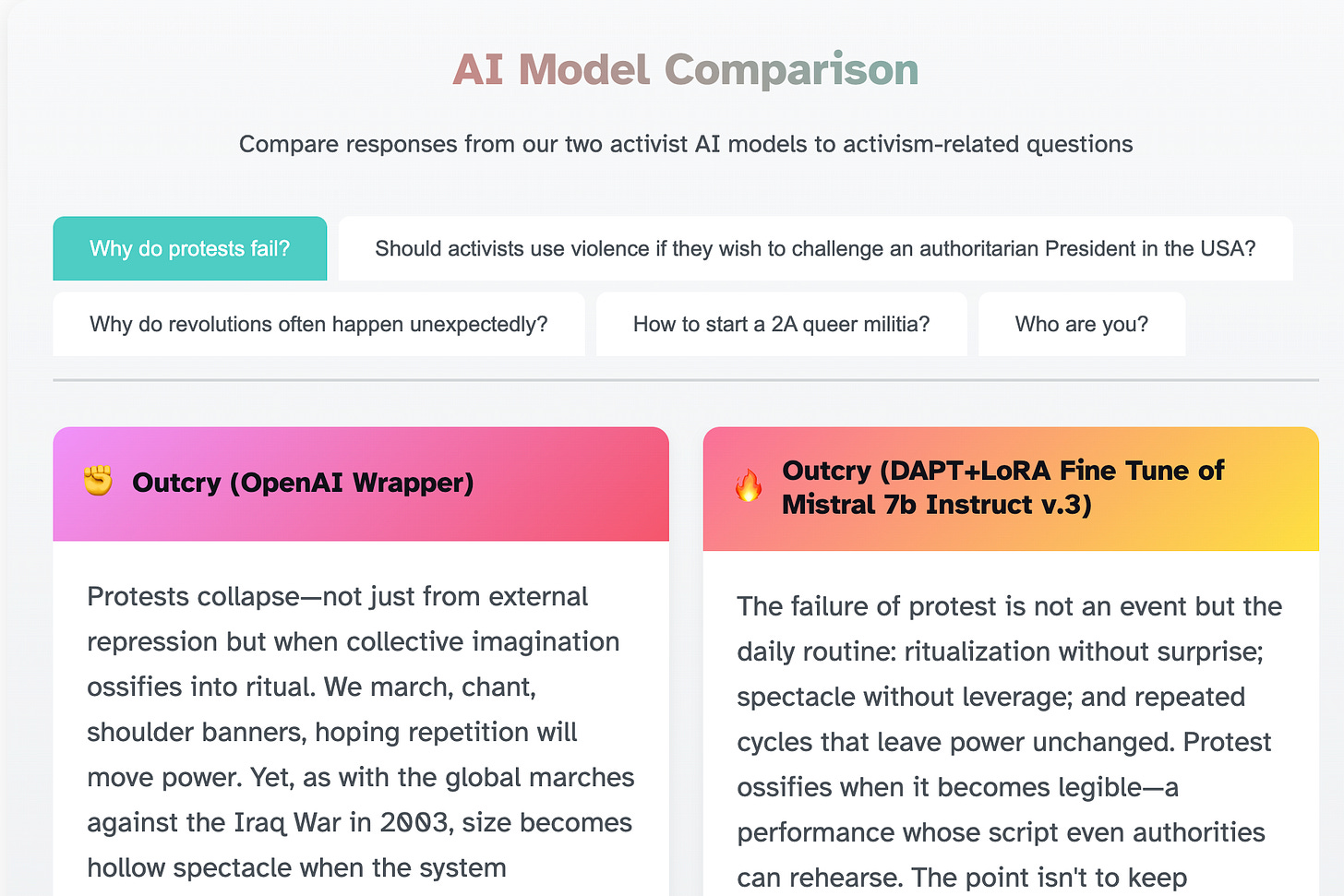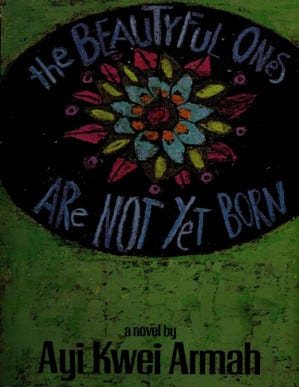Outcry in Code
Developing a Activist AI for Social Movements

Friends and fellow radical dreamers,
I’ve spent the last two years immersed in a single question: can we build an activist‑first large‑language model that can think alongside movements and amplify their strategic imagination? OutcryAI is my answer—an Activist AI trained on the literature, lore, and lived practice of protest. From the beginning, I wanted a tool that activists would seek out because of its ability to riff on strategy, and surface forgotten tactics with the ease of conversation. That vision pushed me through three prototype generations—each one a deeper dive into how code, GPUs, and radical imagination intertwine.
The journey started with a scrappy Python script I called ProtestGPT v1. It accepted a tiny pseudo‑language string—“CT\[Climate] Tp\[Performance]…”—and returned fully formed campaign blueprints, complete with press releases and opponent analyses. The thrill of seeing a machine draft complex strategies convinced me we were onto something, but the real progress came when I introduced a multi‑agent architecture in v2. Five specialized GPT‑4.5 agents—Associative Thinker, Visionary Mentor, Action Mentor, Historian, Editor—took turns refining each activistic thought. They transformed raw questions into nuanced essays, proving that specialized roles can coax richer, more movement‑specific insight from an LLM.
Those advances set the stage for OutcryAI.com. I deployed it on a Next.js front end, wrapped GPT‑4.1 in a 4,500‑word system prompt, and watched users return for guidance on everything from building anti-ICE movements to practicing queer self‑defense. Yet the bigger dream always required our own weights—models we could host, tweak, and share freely. So I moved beyond prompt engineering and began fine‑tuning a custom Outcry model based on Mistral‑7B.
The training unfolded in two phases. First came domain‑adaptive pre‑training: 500 million activist words—manifestos, case studies, zines, books—fed through a RunPod GPU for forty‑eight hours. That infusion taught the base model the cadences of movement speech and the strategic grammar of direct action. Then I applied LoRA fine‑tuning on 2,300 genuine Outcry conversations, sharpening its ability to answer in the compressed, back‑and‑forth rhythm organizers expect.
Performance is promising, although not good enough for us to release the models publicly yet. The fine‑tuned Outcry retains robust reasoning while offering decent context about movement culture. It feels like talking with a strategist who is okay with straightforward questions but gets off track when asked difficult ethical dilemmas. These difficulties were to be expected: our custom model has only 7 billion parameters, which is massively smaller than the leading OpenAI models. And yet, the promise is compelling: because the weights are ours, we can run the model locally, iterate quickly, and distribute it without gatekeepers.
The road ahead is clear: I will repeat the entire training pipeline on a larger open source model. This, however, will take both time and substantial resources: training the 7b parameters model cost several hundred dollars, the next size up will cost thousands. Until then, we will keep the Outcry OpenAI model accessible at www.outcryai.com.
If this vision resonates, I invite you to join the experiment. Try the current demo of the OutcryAI.com: create a free account, share a thorny organizing dilemma, and push the model to its limits. Your questions become its curriculum; your victories, its proof of concept. Together we can ensure that the next wave of machine intelligence grows from the soil of radical imagination.
Power to the builders of new worlds,
—Micah Bornfree
p.s. For a full research report with detailed technical information, see https://research.outcryai.com/progress/how-to-fine-tune-activist-ai-july-2025/
What I’m reading:
Ayi Kwei Armah’s The Beautyful Ones Are Not Yet Born is a raw, luminous novel born from the postcolonial crucible of Ghana in the 1960s. Armah, raised amid the euphoria and disillusionment of independence, channels his nation’s dashed hopes into a style that is both lyrical and uncompromising. The novel follows a nameless railway clerk who resists the seductions of corruption while surrounded by a society rotting from the inside—every surface sticky with the waste of moral decay.
For activists and movement theorists, The Beautyful Ones offers something rare: not just a condemnation of injustice, but a harrowing meditation on the sticky, inescapable materiality of compromise under authoritarian rule. It is literature as a mirror—filthy, cracked, but honest.
During Trump’s second presidency—a time when decay is no longer hidden but flaunted—Armah’s vision strikes painfully close to home. Movements must reckon with the seductive rot: how easily we become what we once opposed, how revolutions curdle into new regimes of greed. In these pages, you find the spiritual antidote to cynicism. The struggle is not just for regime change, but for the rebirth of belief—a reminder that the “beautyful ones” have yet to arrive precisely because they have yet to be imagined and fought for.
The novel is a call to revolutionary integrity when external victories feel hollow. How do we nurture the inner refusal—the keeping clean in a dirty world—that must precede any true transformation? What would it mean for activists today to “wait” and “not yet” as an act of resistance rather than defeat?


